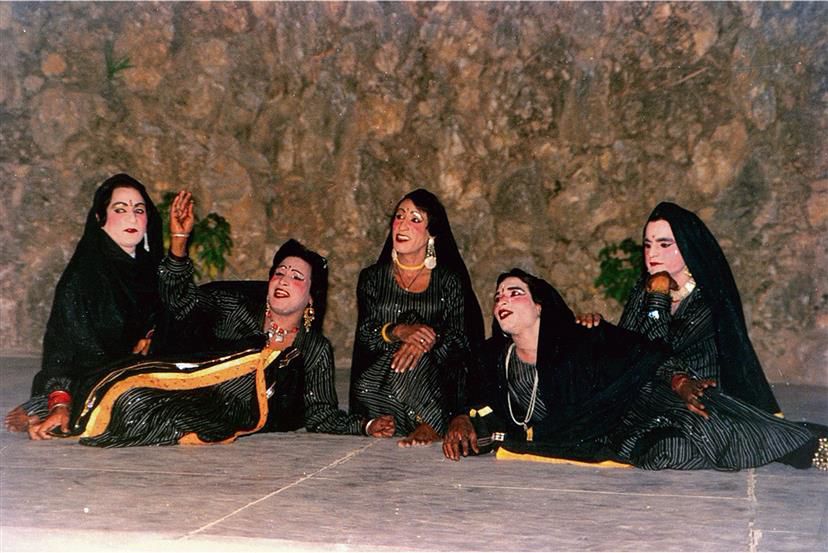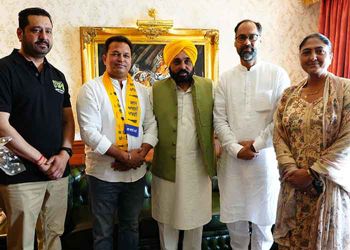
Dressed in a shimmering salwar-kameez with bright and thick lipstick, 16-year-old Pooran Chand (extreme left) would gaze boldly at the audience with a disarming directness. Photo courtesy: prinseps
Neelam Mansingh Chowdhry
THE image of female impersonators never ceases to fascinate, whether they appear in theatre, films, classical or folk performances. Is the female impersonator a sexual subaltern? Or an artiste expressing himself outside conventional templates? The annals of performance arts are replete with stories of famous female impersonators who not only sang and danced, but also set the fashions for the day. The reference that immediately comes to mind is of the famous Marathi actor Bal Gandharva, whose choice of sarees, hairstyle and make-up set the model of style that was faithfully followed by women of high society.

Photo courtesy: Prinseps
History of theatre is full of incredible stories of young men falling in love with a female impersonator and whisking them away as dark secrets. These stories became part of folklore with addendums and subtractions adding to their allure. The female impersonator, who could be perceived as a disorienting figure, had acquired a fantastical status with a presence that hovered between genders and cultures.
Although female impersonation was an established convention in most pre-modern traditions of theatre and dance in South Asia, it entered a new phase in the urban entertainment economy that emerged in mid-19th century Bombay, particularly in the Parsi, Gujarati and Marathi theatres as well as in the early films. Here boys and men played female roles, and their talent in acting, singing and dancing determined the success or failure of the companies to which they were attached. But the flip side was that women were kept out of the acting profession, stating their unavailability due to patriarchal constraints.
I have worked with female impersonators for the last 35 years. Working with them, along with urban actors, made my actors not only realign their concepts towards femininity on stage, but also the way masculinity was constructed for the stage. My work in theatre has been influenced by the presence of these impersonators, who not only sing and dance, but also have the gift of being stand-up comedians. The urban actors have grown up in the city and have obtained an education from drama schools. Putting such a company together makes for a somewhat precarious and unstable meeting of tradition (folk and modern), as between female impersonators and actresses. This destabilises both gender and tradition and shifts attention to the ‘figuration’ of women on stage.
I recall working with Pooran Chand, a young and beauteous 16-year-old female impersonator. Because of his youth, he didn’t look masculine. Dressed in a shimmering salwar-kameez with bright and thick lipstick on his delicate lips, heavily powdered and rouged, I noted that he would gaze boldly at the spectators with a disarming directness during a performance. In fact, it is this directness which paradoxically illuminates the way in which the dancer addresses the male spectator. No one forgets that the dancer is male; the invocation to the non-male is controlled by the security of the performer’s male body. The “female” image so perfectly encoded in Pooran Chand does not bring the female into the spectacle of exchange, but leaves her emphatically outside. In place of the female, a fetishised image is displayed, which substitutes and makes the woman’s presence unnecessary. The fantasy generated by Pooran Chand’s performance is the fantasy of exchange between men about women.
While working with them, I noticed how swiftly they transformed themselves from beefy, jowly men into provocative and seductive female impersonators, without ritual or fanfare. In local traditions, their transformation from male to female was quick and devoid of fuss. The shaving of the arms and chest, the stuffing of the bra with whatever material was available (from rolled up hankies to cotton wool), the smearing of face powder, the painting of their moustache-lined lips into bleeding red smudges, to their antimony-lined eyes — all was done quickly without artifice.
Unlike the classical traditions, the make-up of the female impersonators does not have the transformative skills of a Kabuki actor or a Kathakali artiste. They appear more as an ‘idea’ of a male beneath a woman’s costume. At times, even obvious male characteristics, such as hairy arms and a stubble, would not take away from the exaggerated suggestiveness of the ‘feminine’ in a way that was seductive but not unsettling of gender norms. I noticed that often their portrayal of the feminine side became hyper-feminine, taking gender cues from clothing, hairstyle, make-up and body language. What constitutes the feminine for them? Lipstick? Breasts? Swagger? How are these exaggerated? Brighter lipstick? Larger breasts? Extravagant swagger? These assumptions about the feminine remain, in many respects, masculine.
In the early 18th century, there is a story about a woman who poses as a man to do the role of a female impersonator. The stages that she passes through are the woman becoming the man to play the woman. The twist in the whole tale is that a male member of the audience falls in love with the illusionary woman while the real woman, playing the female impersonator, falls in love with the man. I have always wondered how this romance played out!
During the time of William Shakespeare (1564-1616), women were not employed on the Elizabethan stage. So, Shakespeare wrote all his female roles to be played by boys. Shakespeare had considerable fun with the idea of a boy playing a girl playing a boy, as is the case with Rosalind in ‘As You Like It’ or Viola in ‘Twelfth Night’ and even more theatrically, with the flute-playing Thisby in ‘A Midsummer Night’s Dream’. Boys in professional companies often graduated to male parts as they matured and their voices dropped and their beards grew. When Hamlet first greets the players, he recognises one such fellow and says: “O, old friend! Thy face is valanced since I saw thee last. Com’st thou to beard me in Denmark?”
Underlining all this is the fact that it is a performance for the male, by the male and about the male. It is multi-layered and ambivalently marked. A man playing the role of a woman helps an audience subvert assumptions of cultural propriety. The male audience can take liberties with the female impersonator that would not be possible if there was a ‘real’ woman. The female impersonators are free to act as women, because they are, in reality, not women.
When I started working with them, they disrupted preconceived categorisations of gender positioning and created a fluid and relaxed gender space. In a way, it subverted for me the ‘idea’ of what it means to be a woman or a man on the stage performatively. The man who dresses periodically as a woman sees himself as a woman who is not entirely a woman, but a man minus a man or a man plus a woman.
Join Whatsapp Channel of The Tribune for latest updates.



























